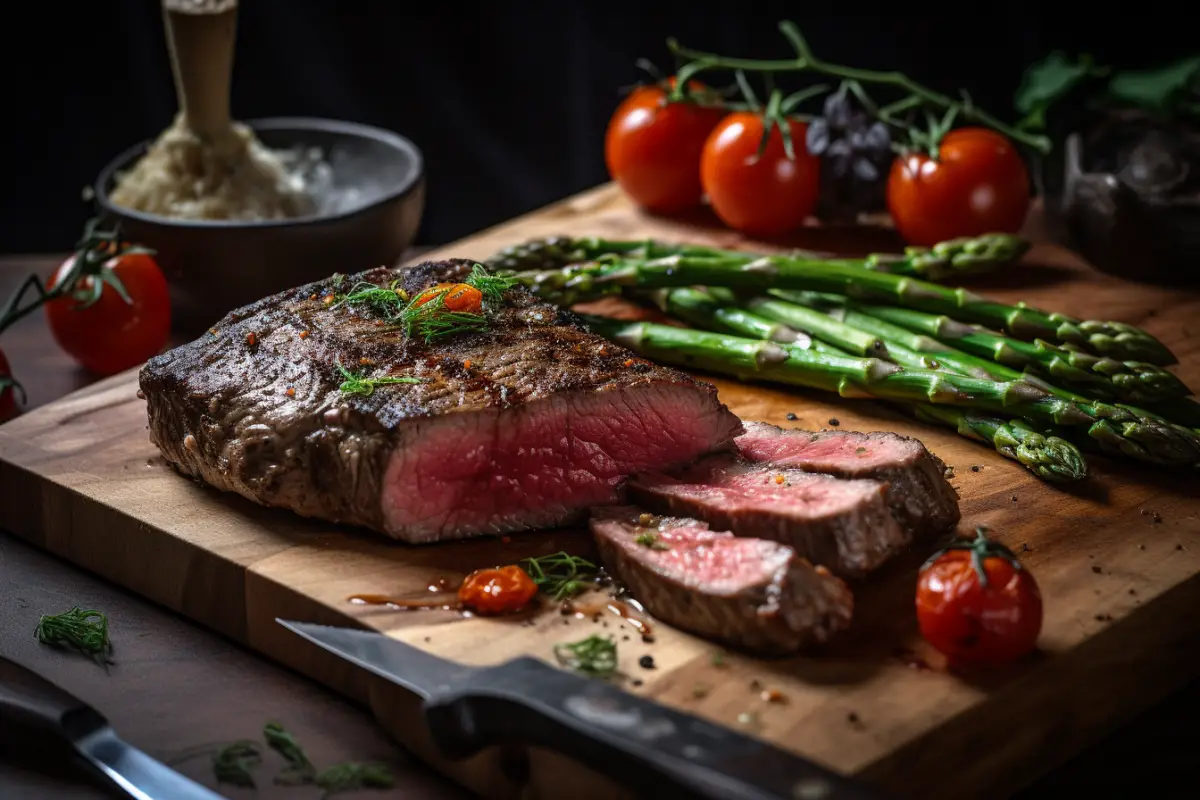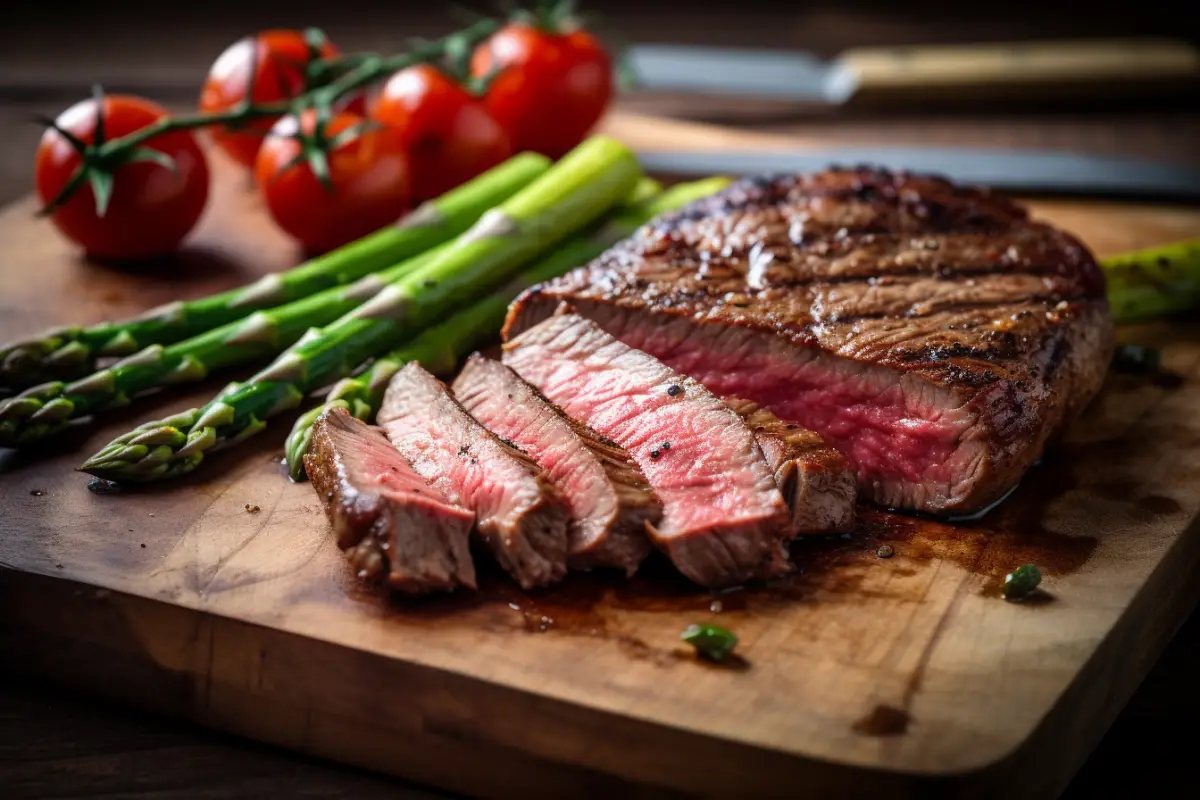If you’re a steak lover looking for a new adventure in flavor and texture, then blue steak might just be the experience you’re craving. Known for its unique preparation and ultra-rare doneness, blue steak offers an entirely different way to enjoy this beloved cut of meat. In this guide, we’ll explore everything you need to know about blue steak—from how it’s cooked to why it’s called “blue,” as well as its safety and taste. Let’s dive into the world of this steak, breaking down its complexities in a simple, approachable way.
What Is Blue Steak?
Definition
This steak, also referred to as blue-rare, is the rarest doneness level for steak. It’s essentially a steak that is seared on the outside while the inside remains almost completely raw. To achieve this, the steak is cooked very briefly, just enough to develop a sear on the outside, while the internal temperature stays below 115°F (46°C). The result is a steak that’s cold or slightly warm on the inside, offering a unique, tender, and juicy texture.
Why Is It Called Blue?
The term “blue” doesn’t refer to the steak turning blue during cooking. Instead, it describes the natural hue of the raw meat before it is cooked. Raw steak has a bluish-purplish tint due to the myoglobin in the muscle fibers, which changes color when exposed to oxygen. As it warms during cooking, it transitions to a red or pink shade. When cooked blue, the meat doesn’t reach a high enough temperature for significant color change, thus keeping some of its original blueish hue.
How Popular Is Blue Steak?
This steak is becoming increasingly popular among steak enthusiasts who enjoy experiencing meat in its purest form. This rare doneness is common in high-end restaurants, especially those offering French cuisine, but is also gaining attention from food lovers who enjoy experimenting with textures and flavors at home.
How to Cook Blue Steak
Best Cuts
Not all cuts of steak are ideal for cooking to blue. The best steaks for blue cooking are those that are lean and tender, as the cooking process doesn’t break down fat and connective tissues as much as longer cooking methods do.
- Filet mignon: This is one of the most tender cuts, making it perfect for this steak.
- Ribeye: With its marbled fat, ribeye offers a flavorful bite even when cooked to blue doneness.
- Sirloin: A slightly more affordable option, sirloin provides great texture when cooked blue and pairs well with a variety of sides.
Step-by-Step Cooking Process
Cooking a perfect blue steak requires attention to detail and precise timing. Here’s a step-by-step guide to help you cook it right every time:
- Bring the steak to room temperature: Before cooking, leave your steak out for about 30 minutes to an hour to bring it to room temperature. This helps ensure even searing on the outside.
- Season the steak: Lightly season the steak with salt and pepper. You don’t need heavy seasoning because the short cooking time doesn’t allow the flavors to fully penetrate the meat.
- Heat your pan or grill: Use a high-quality cast-iron skillet or a grill, and heat it until it’s extremely hot. This high heat will give you the perfect sear on the outside without cooking the inside.
- Sear the steak: Place the steak in the pan or on the grill and sear it for about 60-90 seconds on each side. You’re looking for a crispy, brown crust on the outside while keeping the inside nearly raw.
- Rest the steak: Once you’ve seared both sides, remove the steak from the heat and let it rest for a couple of minutes. This allows the juices to redistribute throughout the meat.
Common Mistakes to Avoid
- Overcooking: The most common mistake when cooking this steak is leaving it on the heat for too long, which results in the inside cooking more than desired.
- Skipping the room temperature step: Not allowing the steak to come to room temperature before cooking can lead to uneven cooking, with a cold center and overly charred exterior.
- Improper seasoning: While this steak doesn’t need much seasoning, skipping this step can result in a bland bite, as the seared crust benefits from the salt and pepper.
The Science Behind Blue Steak
The Internal Temperature of Blue Steak
The key to a blue steak is keeping the internal temperature very low—below 115°F (46°C). This is why the inside of the steak remains nearly raw, with only the outer surface cooked. The result is a very tender, almost melt-in-your-mouth texture. Since the steak never spends much time over heat, its proteins don’t denature the same way they do in higher-temperature cooking methods.

How Cooking Affects the Proteins
Unlike a medium-rare or well-done steak, the proteins in a blue steak remain mostly intact. The lack of heat means the muscle fibers don’t shrink, and the moisture inside the steak is preserved. This gives the steak a juicy, almost buttery texture. The light searing on the outside caramelizes the sugars and adds flavor, but the inside stays soft and tender, making each bite a unique experience.
Is Blue Steak Safe to Eat?
Safety Concerns with Rare Steak
One of the biggest questions people ask is, is blue steak safe to eat? Since this steak is cooked minimally, some people worry about foodborne illnesses, especially if the meat hasn’t been handled properly. However, if the steak is sourced from a reputable butcher or restaurant and handled with care, it’s generally safe to eat.
The outside of the steak is where bacteria typically reside. Since this steak is seared at a high temperature, any harmful bacteria on the surface are killed, making it safer to eat the nearly raw inside.
Best Practices for Ensuring Safety
Here are a few tips to ensure your blue steak is as safe as it is delicious:
- Buy high-quality steak: Always buy your steak from a trusted butcher or grocery store to ensure the meat is fresh and handled properly.
- Store meat properly: Keep your steak refrigerated until you’re ready to cook it, and never leave it out for too long.
- Use a clean surface: Make sure your cutting boards, utensils, and workspaces are clean to prevent cross-contamination.
Who Should Avoid Blue Steak?
Certain individuals should avoid consuming this steak due to its rare nature. Pregnant women, the elderly, and anyone with a compromised immune system should avoid eating raw or undercooked meat, as they are more susceptible to foodborne illnesses.
Flavor and Texture Profile of Blue Steak
What Does Blue Steak Taste Like?
The flavor of this steak is quite distinct. Unlike steaks cooked to medium or well-done, this steak maintains the natural, slightly metallic flavor of raw meat. It’s often described as fresh, pure, and lightly sweet, with the seared outer layer adding a burst of caramelized flavor.
Texture of Blue Steak
The texture of blue steak is what sets it apart from other doneness levels. Because the inside remains mostly raw, it’s soft, tender, and juicy. The outer seared layer provides a slight crunch, while the inside is almost buttery in texture. Some describe it as melt-in-your-mouth, while others note a slightly chewy consistency that they find pleasant.
Blue Steak vs. Rare Steak: What’s the Difference?
Temperature Difference
Both blue steak and rare steak are on the rare end of the doneness spectrum, but there’s a distinct difference between the two. A blue steak is cooked to an internal temperature of less than 115°F (46°C), while a rare steak is cooked between 120°F and 130°F. This slight difference in temperature means that a rare steak is still mostly raw inside but has a slightly more cooked texture than this steak.
Texture and Flavor Differences
The texture of blue steak is much softer and juicier than rare steak due to its lower internal temperature. In terms of flavor, rare steak has a slightly more pronounced beefy taste because the proteins have started to cook, while this steak retains a more delicate and raw flavor.
Cultural Perspectives: Where is Blue Steak Most Popular?
Blue Steak in French Cuisine
This steak has its roots in French cuisine, where it’s known as “bleu.” French chefs and diners have long appreciated the pure, unadulterated flavor of blue steak, and it’s often found on the menus of high-end French restaurants. The French take pride in cooking steak to perfection, and the blue style is considered a delicacy for those who enjoy rare meat.
Blue Steak in Other Cultures
Beyond France, this steak is gaining popularity in various parts of the world, especially in fine dining establishments that cater to steak aficionados. In the U.S., it’s becoming more common in upscale steak houses, and food enthusiasts who appreciate the art of cooking meat are eager to explore this unique preparation style.
Perfect Pairings for Blue Steak
Best Side Dishes
Because this steak has such a delicate flavor, you’ll want to pair it with sides that complement rather than overpower it. Here are a few perfect pairings:
- Light salads: A simple green salad with a light vinaigrette adds freshness without overshadowing the steak.
- Grilled vegetables: Grilled asparagus, zucchini, or bell peppers offer a nice smoky flavor to balance the richness of the steak.
- Mashed or roasted potatoes: Creamy mashed potatoes or crispy roasted potatoes make for a classic steakhouse pairing.
Wine and Beverage Pairings
The delicate flavor of blue steak pairs beautifully with wines that are not too bold or tannic. Here are some excellent options:
- Cabernet Sauvignon: A full-bodied red wine that complements the richness of the steak without overwhelming its subtle flavors.
- Pinot Noir: A lighter red wine with a fruity profile that pairs well with the fresh taste of this steak.
- Chardonnay: For those who prefer white wine, a lightly oaked Chardonnay adds a buttery richness that complements the steak’s texture.
Frequently Asked Questions (FAQs)
1. Is it okay to eat blue steak?
Yes, this steak is generally safe to eat as long as it’s made from high-quality meat, properly seared on the outside, and handled with care to avoid contamination.
2. What is a blue steak?
This steak is the rarest form of steak, seared on the outside and left mostly raw inside. Its internal temperature remains below 115°F (46°C).
3. Is blue steak cold in the middle?
A properly cooked this steak may be slightly cool or warm in the middle, as the inside remains nearly raw.
4. What temperature is blue rare?
Blue rare refers to a steak cooked to an internal temperature below 115°F (46°C), with a brief sear on the outside.
Conclusion: Should You Try Blue Steak?
Blue steak is a rare delicacy that offers a unique eating experience for steak lovers who enjoy their meat nearly raw. With its tender, juicy texture and pure, unadulterated flavor, it’s perfect for those looking to explore a new way to enjoy steak. While it may not be for everyone, especially those who prefer their meat more cooked, this steak is an exciting option for adventurous eaters. So next time you’re at a high-end steakhouse or cooking at home, why not give blue steak a try?

